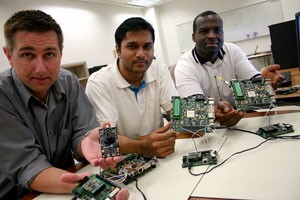Science and Technology
With recent work being done at the UA, space shuttles that have technical difficulties might not need humans to fix them – they will fix themselves.
Ali Akoglu, an assistant professor in electrical and computer engineering, is working with his students on the Scalable Self-Configurable Architecture for Reusable Space Systems project.
“”We are trying to have software that imitates a living organism,”” he said. “”I am very much interested in imitating our body’s response to a minor cut on a reconfigurable hardware.””
The concept, nicknamed SCARS, was introduced as a class project in 2006 and is now a graduate class.
In June, Akoglu’s students wrote a paper and submitted it to NASA; the space agency’s Jet Propulsion Lab decided to provide $85,000 in funding.
Currently, three graduate students and two undergraduates contribute. They have developed a small-scale prototype with five nodes, each with a camera, as the students use the device for image processing.
With SCARS, if one of the nodes became damaged, the system would still function once it reconfigured itself – by enlisting another node to take on more work, Akoglu said.
“”If you have five robots that all have specific tasks, and one gets damaged and cannot perform that task, that task could not be completed usually,”” he said. “”In our case, the task would still be completed because another robot would take on the tasks of the nonfunctioning one, and both tasks would be completed.””
“”Originally, this seemed like a risky idea, but now we have something working, and I’m excited,”” he said.
Spacecraft today have two replicas of computer systems onboard so a backup is available, as humans are not around to fix the original, he said.
“”This is very expensive and is a lot of additional weight,”” Akoglu said. “”We want to replace this with a single unit that can configure itself.””
The technology would also be useful if an objective changes halfway through a mission, as systems could reconfigure themselves, he said.
After Akoglu can prove the technology is feasible – possibly within the next five years, he said – the next step will be to get a platform, which they will work on with NASA’s Jet Propulsion Lab.
SCARS can be built into spacecrafts like Mars rovers and robots, as well as rockets, he said.
Kevin Carr, an electrical engineering senior, is one of the students working with the prototype.
“”This is the way of the future,”” he said. “”The concept of self-healing is great because if something breaks in space there is redundancy to back it up.””
The Discovery Channel has taken an interest in the project and will film the project in Akoglu’s lab this fall, Akoglu said.









